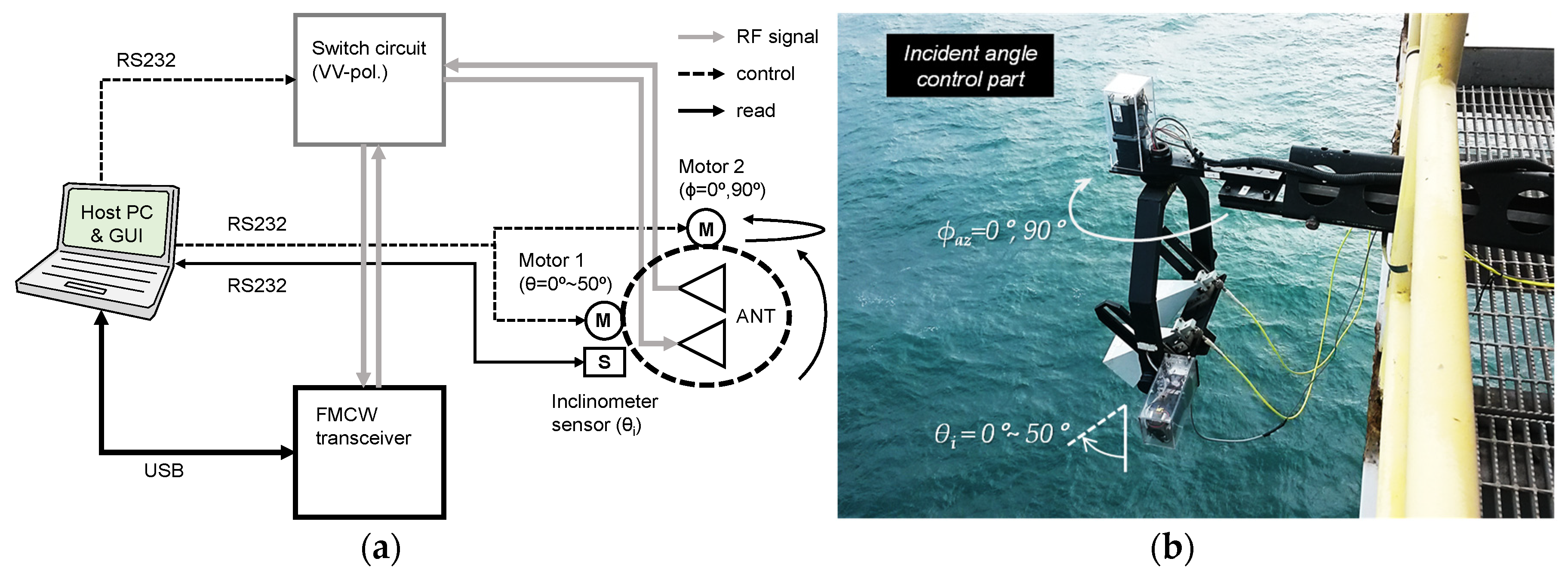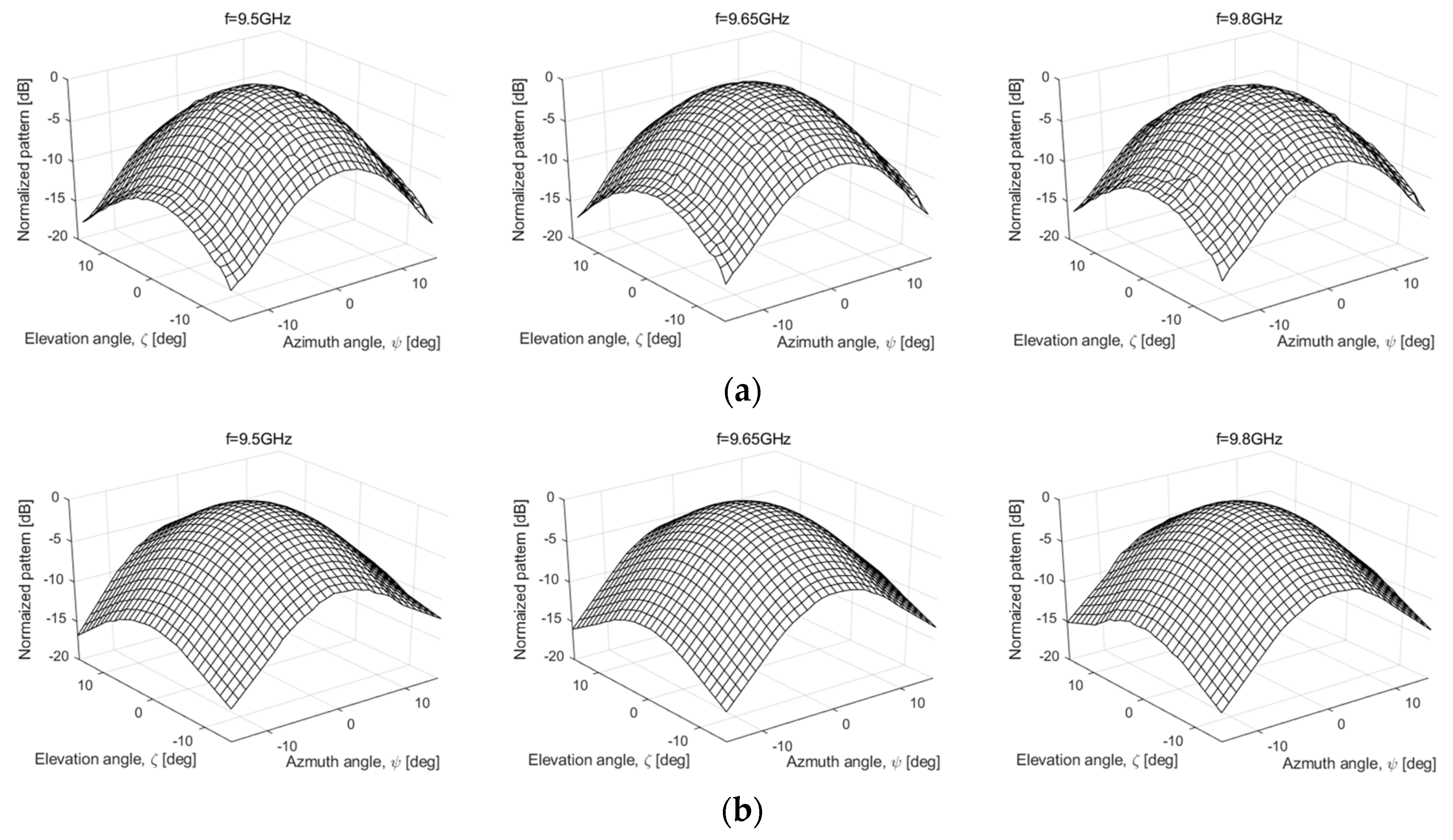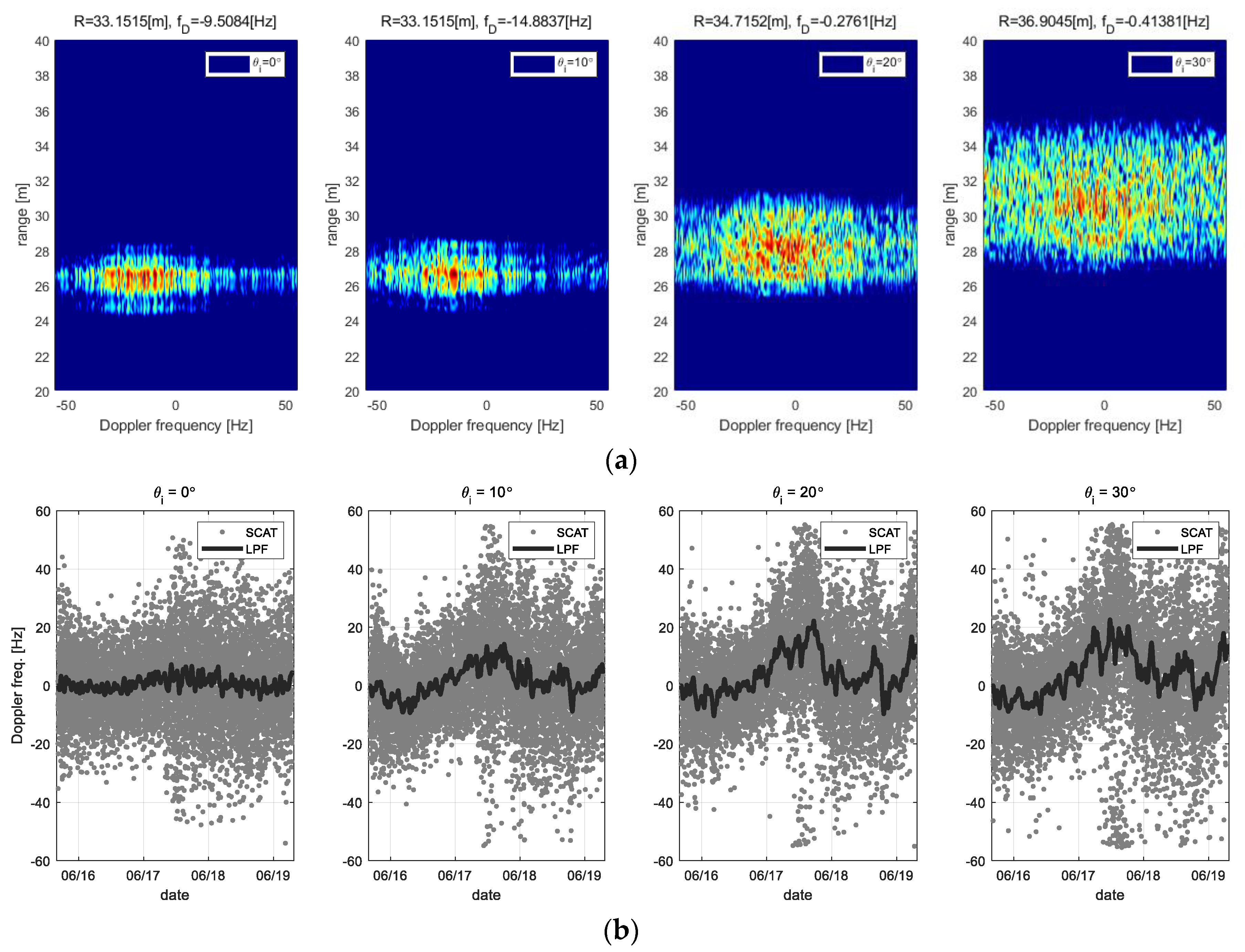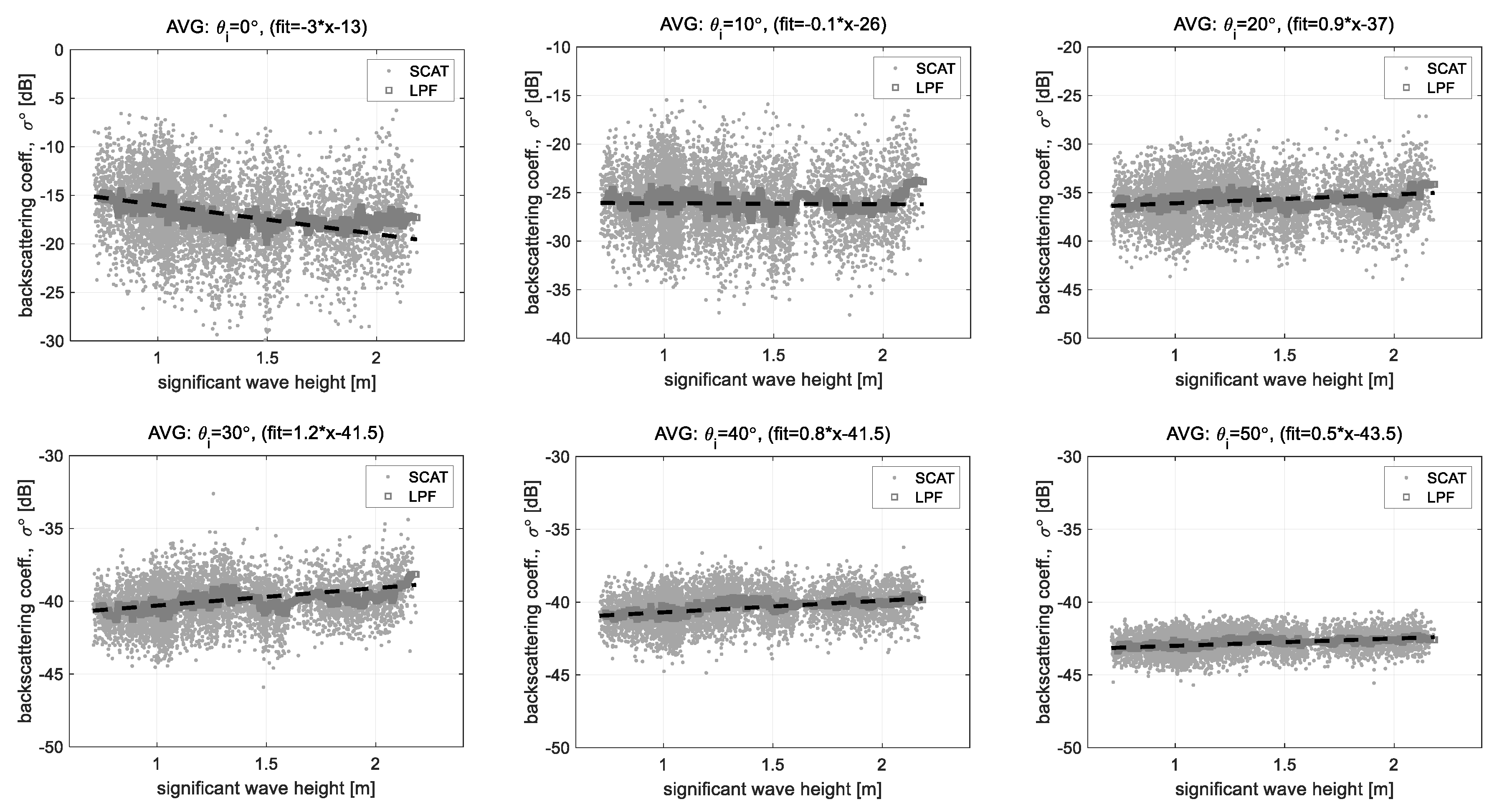Multifunctional Scatterometer System for Measuring Physical Oceanographic Parameters Using Range-Doppler FMCW Radar
Abstract
:1. Introduction
2. FMCW Signal Model and Range-Doppler Processing
2.1. FMCW Signal Model
2.2. Range-Doppler Signal Processing
3. Self-Manufactured FMCW Scatterometer System
3.1. Self-Manufactured FMCW Radar Transciever
3.2. Configuration of Scatterometer System
4. Operation of the Multifunctional Scatterometer System
4.1. Automatic Measure Sequence
4.2. Calibration for Scatterometer System and Data
5. Analysis of Measurement Data: (Signal Process and Data Correlation)
5.1. Distance (R) vs. Wave Height
5.2. Doppler Frequency (fD) vs. Wind Speed and Direction
5.3. Backscattering Coefficient (σ°) vs. Sea State
6. Observational Results
6.1. Tidal Level and Significant Wave Height
6.2. Wind Speed and Direction
6.3. Sea State: (Significant Wave Height and Wind Speed)
7. Conclusions
Author Contributions
Funding
Institutional Review Board Statement
Informed Consent Statement
Data Availability Statement
Acknowledgments
Conflicts of Interest
References
- Cavaleri, L. The oceanographic tower Acqua Alta-more than a quarter of century activity. Il Nouovo Cim. C 1999, 22, 1–112. [Google Scholar]
- Cavaleri, L. The oceanographic tower Acqua Alta-activity and prediction of sea states at Venice. Coast. Eng. 2000, 39, 29–70. [Google Scholar] [CrossRef]
- Huang, W.; Carrasco, R.; Shen, C.; Gill, E.W.; Horstmann, J. Surface current measurements using X-band marine radar with vertical polarization. IEEE Trans. Geosci. Remote Sens. 2016, 54, 2988–2997. [Google Scholar] [CrossRef]
- Carrasco, R.; Streßer, M.; Horstmann, J. A simple method for retrieving significant wave height from Dopplerized X-band radar. Ocean. Sci. 2017, 31, 95–103. [Google Scholar] [CrossRef] [Green Version]
- Carrasco, R.; Horstmann, J.; Seemann, J. Significnat wave height measured by coherent X-band radar. IEEE Trans. Geosci. Remote Sens. 2017, 55, 5355–5365. [Google Scholar] [CrossRef]
- Shim, J.S.; Chun, I.S.; Min, I.K. Construction of Ieodo ocean research station and its operation. In Proceedings of the Fourteenth International Offshore and Polar Engineering Conference, Toulon, France, 23–28 May 2004. [Google Scholar]
- Choi, D.Y.; Woo, H.J.; Park, K.; Byun, D.S.; Lee, E. Validation of sea surface wind speed from satellite altimeters and relation to sea state bias–-focus on wind measurements at Ieodo, Marado, Oeyeondo stations. Korean Earth Sci. Soc. 2018, 39, 139–153. [Google Scholar] [CrossRef]
- Singh, R.; Kumar, P.; Pal, P.K. Assimilation of Oceansat-2-Scatterometer-Derived Surface Winds in the Weather Research and Forecasting Model. IEEE Trans. Geosci. Remote Sens. 2012, 50, 1015–1021. [Google Scholar] [CrossRef]
- Durden, S.L.; Perkovic-Martin, D. The RapidScat Ocean Winds Scatterometer: A Radar System Engineering Perspective. IEEE Geosci. Remote Sens. Mag. 2017, 5, 36–43. [Google Scholar] [CrossRef]
- Malenovský, Z.; Rott, H.; Cihlar, J.; Schaepman, M.E.; García-Santos, G.; Fernandes, R.; Berger, M. Sentinels for science: Potential of Sentinel-1, -2, and -3 missions for scientific observations of ocean, cryosphere, and land. Remote Sens. Environ. 2012, 120, 91–101. [Google Scholar] [CrossRef]
- Meta, A. Signal Processing of FMCW Synthetic Aperture Radar Data. Ph.D. Thesis, Delft University of Technology, Delft, The Netherlands, 2006; pp. 61–72. [Google Scholar]
- Skolnik, M. Indroduction to Radar System, 2nd ed.; McGrawHill: New York, NY, USA, 2002; pp. 70–98. [Google Scholar]
- Skolnik, M. Radar Handbook, 3rd ed.; McGrawHill: New York, NY, USA, 2008; pp. 2.2–2.19 & 16.19–16.56. [Google Scholar]
- Zaugg, E.C.; Long, D.G. Generalized frequency scaling and backprojection for LFM-CW SAR processing. IEEE Trans. Geosci. Remote Sens. 2015, 53, 3600–3614. [Google Scholar] [CrossRef]
- Meta, A.; Hoogeboom, P.; Ligthart, L.P. Signal Processing for FMCW SAR. IEEE Trans. Geosci. Remote Sens. 2007, 45, 3519–3532. [Google Scholar] [CrossRef]
- Sarabandi, K.; Ulaby, F.T. A convenient technique for polarimetric calibration of single-antenna radar systems. IEEE Trans. Geosci. Remote Sens. 1990, 28, 1022–1033. [Google Scholar] [CrossRef]
- Sarabandi, K.; Ulaby, F.T. Measurement and calibration of differential mueller matrix of distributed targets. IEEE Trans. Anrennas Propag. 1992, 40, 1524–1532. [Google Scholar] [CrossRef]
- Fung, A.K.; Li, Z.; Chen, K.S. Backscattering from a randomly rough dielectric surface. IEEE Trans. Geosci. Remote Sens. 1992, 30, 356–369. [Google Scholar] [CrossRef]
- Fung, A.K.; Chen, K.S.; Chen, K.S. Microwave Scattering and Emission Models for Users; Artech House: Norwood, MA, USA, 2010. [Google Scholar]
- Korea Hydrographic and Oceanographic Agency, Ieodo Ocean Research Station. Available online: http://khoa.go.kr/ors/station_intro1.do (accessed on 23 September 2021).
- Carrara, W.G.; Goodman, R.S.; Majewski, R.M. Spotlight Synthetic Aperture Radar: Signal Processing Algorithm; Artech House: Norwood, MA, USA, 1995; pp. 501–506. [Google Scholar]
- Hwang, J.H.; Lee, K.Y.; Park, S.M.; Oh, Y.S. Design of a full polarimetric scatterometer for X-band. J. Korean Inst. Electromagn. Eng. Sci. 2009, 20, 1308–1315. [Google Scholar] [CrossRef] [Green Version]
- Hwang, J.H.; Park, S.M.; Kwon, S.G.; Oh, Y.S. Study on the calibration of a full-polarimetric scatterometer system at X-band. J. Korean Inst. Electromagn. Eng. Sci. 2010, 21, 408–416. [Google Scholar] [CrossRef]
- WMO Sea State Code. Available online: http://en.wikipedia.org/wiki/Seastate#WMOseastatecode (accessed on 23 September 2021).
- Jin, Y.Q. Theory and Approach of Information Retrievals from Electromagnetic Scattering and Remote Sensing; Springer: Berlin/Heidelberg, Germany, 2006; pp. 235–240. [Google Scholar]
- Kanevsky, M.B. Radar Imaging of the Ocean Waves; Elsevier Science: Amsterdam, The Netherlands, 2008; pp. 9–24. [Google Scholar]

























| Parameters | Specification | Notes |
|---|---|---|
| Operating frequency (f0) | 9.65 GHz | Bandwidth 500 MHz |
| Chirp rate (Kr) | 500 × 109 | (Kr = BW/Tr) |
| Fast-time period (Tr) | 1 ms | - |
| Fast-time (t) | 1200 samples | (fADC = 1.2 MHz) |
| Slow-time period (Tη) | 1 s | - |
| Slow-time (η) | 100 arrays | (fPRF = 100 Hz) |
| Beat freq.-range ratio (fb/R) | 3.33 kHz/m | (fr, max = fADC/2, Rmax ≈ 190 m) |
| Target distance (R0) | 106 m | Incident angle (θi = 20°) |
| Target velocity (vt) | 1 m/s | (fD = 2f0·vt/c·sinθi) |
| Radar Parameters | Specifications | Notes |
|---|---|---|
| Operating frequency | f0 = 9.65 GHz, BW = 498 MHz | FMCW transceiver |
| Tx power | ~3 Watts | - |
| Chirp rate (Kr) | ~498 × 109 Hz/s | (Kr ≈ BW/Tr) |
| Fast-time sampling | Tr ≈ 1 ms, fADC ≈ 1.2 MHz | (1252 samples) |
| Slow-time sampling | Tη ≈ 1 s, fPRF ≈ 100 Hz | (100 arrays) |
| Incident angle | θi = 0°~50°, ϕaz = 0°, 90° | Motion-control part |
| Tx/Rx antenna | HPBW (θ = 12°, ϕ = 10°) | - |
| Polarization | Vertical | (full-pol. available) |
| Darwin Symbol | M2 | S2 | N2 | K1 | O1 | M4 | M6 | MK3 | S4 | MN4 |
|---|---|---|---|---|---|---|---|---|---|---|
| H(n) | 0.219 | 0.338 | 0.385 | 0.250 | 0.022 | 0.007 | 0.025 | 0.019 | 0.009 | 0.001 |
| K(n) | 175.5° | 337.4° | 239.3° | 211.2° | 51.71° | 323.6° | 105.5° | 117.3° | 1.11° | 14.23° |
| Radar Parameters | Observation Items | RMSE (‘SCAT’ vs. ‘In-Situ’) | Notes |
|---|---|---|---|
| Distance (R) | Tide | 0.169 m | (1) Altimeter mode |
| Significant wave height | 0.127 m | ||
| Doppler frequency (fD) | Wind speed | 1.880 m/s | (2) Scatterometer mode (extended function) |
| Wind direction | 18.84° | ||
| backscattering coefficient (σ°) | Wind speed | 2.094 m/s | (2) Scatterometer mode |
| Significant wave height | 0.365 m |
Publisher’s Note: MDPI stays neutral with regard to jurisdictional claims in published maps and institutional affiliations. |
© 2022 by the authors. Licensee MDPI, Basel, Switzerland. This article is an open access article distributed under the terms and conditions of the Creative Commons Attribution (CC BY) license (https://creativecommons.org/licenses/by/4.0/).
Share and Cite
Hwang, J.-H.; Kim, D.-j.; Kang, K.-M. Multifunctional Scatterometer System for Measuring Physical Oceanographic Parameters Using Range-Doppler FMCW Radar. Sensors 2022, 22, 2890. https://doi.org/10.3390/s22082890
Hwang J-H, Kim D-j, Kang K-M. Multifunctional Scatterometer System for Measuring Physical Oceanographic Parameters Using Range-Doppler FMCW Radar. Sensors. 2022; 22(8):2890. https://doi.org/10.3390/s22082890
Chicago/Turabian StyleHwang, Ji-Hwan, Duk-jin Kim, and Ki-Mook Kang. 2022. "Multifunctional Scatterometer System for Measuring Physical Oceanographic Parameters Using Range-Doppler FMCW Radar" Sensors 22, no. 8: 2890. https://doi.org/10.3390/s22082890







